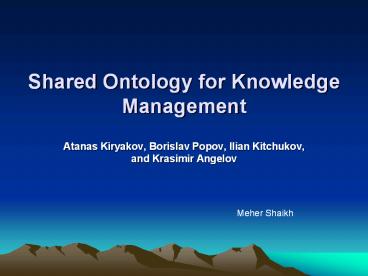Shared Ontology for Knowledge Management - PowerPoint PPT Presentation
1 / 14
Title:
Shared Ontology for Knowledge Management
Description:
KIM platform: allows semantic annotation, ... Ilian Kitchukov, and Krasimir Angelov Overview The authors present an approach for semantic searching on the web. – PowerPoint PPT presentation
Number of Views:199
Avg rating:3.0/5.0
Title: Shared Ontology for Knowledge Management
1
Shared Ontology for Knowledge Management
- Atanas Kiryakov, Borislav Popov, Ilian Kitchukov,
and Krasimir Angelov
Meher Shaikh
2
Overview
- The authors present an approach for semantic
searching on the web. - Indexing schema based on entity occurrence.
- Demonstrate scalable implementation of the
indexing. - KIM platform allows semantic annotation,
indexing of documents with respect to named
entities (NE). - CORE module based on co-occurrence of entities.
- User Interface CORE Search and Timelines
3
Objective
- The contemporary search engines uses ranking to
provide the relevant information based on string
tokens. - Involves semantic analysis of the data on the
web. - Example query telecom company in Europe John
Smith director - Information need A telecom company in Europe, a
person called John Smith, and a management
position. - A document containing the following sentence
would not be returned using conventional search
techniques. - The search engine needs to be able to consider
several semantic relation and inference rule to
return this above document.
4
Traditional IR
- Vector-Space Model (VSM) The documents are
characterized by the token appearing in them. The
model evaluates the similarity between the query
tokens and the tokens appearing in documents to
retrieve and rank the documents.
5
Shared Ontology Approach
- Combines the advantages of the semantic
repository and the raw power of relational
databases. - Semantic repository allows inferring and querying
on top of formal knowledge. The relational
databases can handle large volumes of data
efficiently.
6
KIM
- The platform provides infrastructure for
automatically extracting named entities (semantic
annotations) from the unstructured text. This
includes attributes and relations. The extracted
information is presented in a knowledge base
called the semantic repository. The semantic
annotations are then used for indexing of the
documents.
7
Semantic repository repository of entities and
their relations
Example The semantic repository infers that
London is part of UK
8
Partial Architecture of KIM Platform
9
CORE module
- Extension of KIM platform with advanced UI
- Based on robust open source platforms specialized
in ontology management, text mining and IR. - Focuses on co-occurrence of entities.
10
CORE module cont..
- Maintains bi-directional relations between entity
and documents. - This allows retrieval of entities by documents in
addition to retrieval of documents by entities. - Provides incremental searching, ranking, and
tracking and popularity timelines of these
entities.
11
User Interface CORE Search
12
User Interface Timelines
- Timelines interface allows trends to be
calculated and conveniently viewed and - navigated through.
13
(No Transcript)
14
Conclusion
- More Meaningful content extracted using semantic
analysis and inference. - The KIM Platform and its CORE module currently
achieve real-time retrieval from about a million
documents and a million of entity descriptions.
Work is ongoing to deal with the large amount of
web resources - Synchronization techniques between database and
the semantic repository yet to mature.































